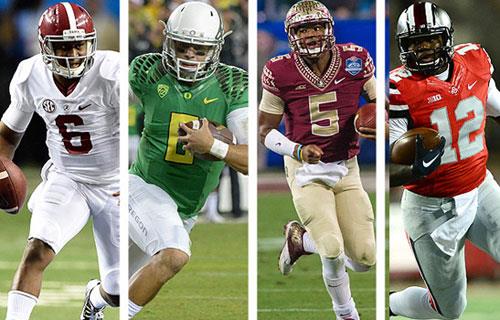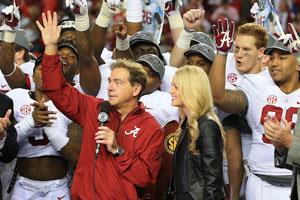
Finally, a college football season will settle bar arguments around the country…or will it?
Collegiate national championships have been tainted, questioned, argued, challenged, disputed (you fill in the verb or your choice) for so long that those fans among us who are of a certain age never imagined that a big-time playoff ever would take place. The difficulty, college presidents argued over the years, was that a football playoff would extend the schedule to a point that would imperil the academic schedule for student athletes.
Sure.
Somehow that was no obstacle for small colleges whose championships for eons have been decided on the gridiron and not through voting by coaches, voting by writers and the machinations of a computer that never played a down of football.
 As TV broadcast rights contracts increased to what student athletes would describe as ginormous, it’s amazing how the extended schedule shrunk as an obstacle to a national title game. So Alabama (12-1 and ranked No. 1) will play No. 4 Ohio State (12-1, and now relying on the third quarterback to start in this season) in the New Year’s Day Sugar Bowl. The other half of the bracket will be decided that same day in the Rose Bowl, pitting No. 2 Oregon, which features the 2014 Heisman Trophy winner at quarterback, against No. 3 Florida State, which is undefeated and considerably unloved because of all the disciplinary questions stirred by the 2013 Heisman Trophy winning quarterback. Fans already want to see Oregon’s Marcus Mariota on a Wheaties box and FSU’s Jameis Winston on a post office wall. Life is hard for all-world QBs.
As TV broadcast rights contracts increased to what student athletes would describe as ginormous, it’s amazing how the extended schedule shrunk as an obstacle to a national title game. So Alabama (12-1 and ranked No. 1) will play No. 4 Ohio State (12-1, and now relying on the third quarterback to start in this season) in the New Year’s Day Sugar Bowl. The other half of the bracket will be decided that same day in the Rose Bowl, pitting No. 2 Oregon, which features the 2014 Heisman Trophy winner at quarterback, against No. 3 Florida State, which is undefeated and considerably unloved because of all the disciplinary questions stirred by the 2013 Heisman Trophy winning quarterback. Fans already want to see Oregon’s Marcus Mariota on a Wheaties box and FSU’s Jameis Winston on a post office wall. Life is hard for all-world QBs.
The 2014 college football season, though, was a grind. Leagues dubbed the Big 5 power conferences (Atlantic Coast, Big 10, Big 12, Pac-12 and the SEC) comprise the teams that are football’s version of investment banks – too big to fail, or in this case, to be excluded from the final four. In fact, jibber jabber up and down bar rails across the South had three Southeastern Conference teams playing among the four who would contest for the national title. It even got giddier when the SEC West briefly lined up four of the top five teams in the country. In the end, though, Alabama had to take care of an upstart Missouri team in the SEC championship game to make sure that the league would be represented at all in the final four.
Mostly that meant Baylor and TCU, each with a single loss and ranked No. 5 and No. 6 in the Dec. 7 College Football Playoff rankings, didn’t really appreciate the four-team playoff. Throughout the season, there were calls for expanding the bracket next year even before the four this year were identified.
Baylor and TCU cannot be distraught. Each of the Big 5 leagues will get $50 million, according to estimates by ESPN, even if the conference doesn’t have a team in the playoffs. About $6 million will go to each of the four playoff teams, according to ESPN. That’s just one aspect of the money that will be paid to conferences and teams for their participating in the array of bowls not involved in the playoffs. Even independent schools, with Notre Dame leading the way at $3.75 million, according to ESPN, get a bite of the pie.
Now, a pause for nostalgia.
Remember when Jan. 1 boasted the best of the bowls and that long day on the couch ended with the bittersweet notion that college football was over until spring football – except for a couple of all-star games? That’s the way it should have been. Hard-headed adherence to weekend games, even though it’s the holiday season, has led to “schedule creep.”
The Jan. 1 Rose and Sugar Bowls are preliminaries to the Jan. 12 national championship game, and should be left on the New Year’s day schedule, even though the holiday is Thursday. The nearly two weeks will give teams time to prepare for Jan. 12. But why does the Armed Forces Bowl in Fort Worth, Texas, or the Tax Slayer Bowl from Jacksonville, Fla. (remember when it was the good old Gator Bowl?), or the Alamo Bowl from San Antonio or the Cactus Bowl from Tempe, Arizona, get Jan. 2 TV time? That makes the games seem so anti-climactic, not to mention the Jan. 3 Birmingham Bowl or the Jan. 4 GoDaddy.com Bowl from Mobile, Alabama.
Why, oh why?
Starting with the Dec. 20 New Orleans Bowl, college football zealots will have 38 bowl games (all but three of them on ESPN and ESPN2) on which to engorge before feasting on the national title bowl. It’s bound to be one for the records, what with so many appealing story lines. To wit: Will Alabama expand its national championship trophy case? Will Oregon show that the Pac-12 indeed has the muscle to win the big one? Will Florida State continue to “refuse to lose”? Will Ohio State win the whole thing despite starting its third-string quarterback? Just imagine all that intrigue against a background of unadulterated rah-rah.
That works for nearly everybody except fans in Fort Worth (think TCU) and Waco (think Baylor). Those among the two schools’ faithful who’ll admit to snagging a leg in a bar stool will argue that their team should have been in the playoff.
It’s hard to argue though that the last team standing shouldn’t hold the national championship. College football really is a vibrant call to alumni pride, in spite of the hundreds of millions of dollars that call the plays in this age of TV contracts.